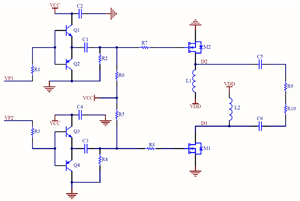A Modified Design of Class-E Power Amplifier with Balanced FETs and High Output Power for RFID Applications
DOI:
https://doi.org/10.46604/peti.2021.7442Keywords:
class-E power amplifier, RFID applications, high output power, matching network, balanced FETAbstract
In Radio Frequency (RF) communication, a Power Amplifier (PA) is used to amplify the signal at the required power level with less utilization of Direct Current (DC) power. The main characteristic of class-E PA is sturdy nonlinearity due to the switching mode action. In this study, a modified design of class-E PA with balanced Metal Oxide Semiconductor Field Effect Transistors (MOSFETs) and high output power for Electronic Article Surveillance (EAS) Radio Frequency Identification (RFID) application is presented. MOSFETs are adjusted to have high output performance of about 80% for RFID-based EAS system. A matching network is also proposed for accurate matching because there are differences in the behavior between RF waves and low frequency waves. The design of a matching network is a tradeoff among the complexity, adjustability, implementation, and bandwidth for the required output power and frequency. The implemented PA is capable of providing 44.8 dBm output power with Power-Added Efficiency (PAE) of 78.5% at 7.7 MHz to 8.7 MHz.
References
S. Cripps, RF Power Amplifiers for Wireless Communications, 2nd ed. Norwood: Artech House, 2006.
J. C. Du, Z. G. Wang, J. Xu, X. Chen, and T. Z. Qin, “A Differential Class‐E Power Amplifier with Dynamic Body Bias Technique,” Microwave and Optical Technology Letters, vol. 62, no. 1, pp. 130-136, September 2019.
P. Colantonio, F. Giannini, and E. Limiti, High Efficiency RF and Microwave Solid State Power Amplifiers, United States: John Wiley & Sons, 2009.
J. Pang, Y. Li, Y. Zhang, X. Y. Zhou, Z. Dai, and A. Zhu, “Analysis and Design of Highly Efficient Wideband RF-Input Sequential Load Modulated Balanced Power Amplifier,” IEEE Transactions on Microwave Theory and Techniques, vol. 68, no. 5, pp. 1741-1753, May 2020.
I. Casallas, C. Páez, A. Fajardo, and G. Perilla, “Design Methodology of Class-E Power Amplifier Using Feed Inductance Tuning for High-Efficiency Operation in Wireless Power Transfer Applications,” IEEE ANDESCON, October 2020, pp. 1-6.
M. N. Zahid, J. Jiang, U. Rafique, and D. Eric, “Modified Planar Square-Loop Antenna for Electronic Article Surveillance Radio Frequency Identification Applications,” Journal of Communication Technology and Electronics, vol. 65, no. 10, pp. 1161-1166, October 2020.
P. Afanasyev, A. Grebennikov, R. Farrell, and J. Dooley, “Broadband Operation of Class-E Power Amplifier with Shunt Filter,” 18th IEEE International New Circuits and Systems Conference, June 2020, pp. 54-57.
F. Moloudi and H. Jahanirad, “Broadband Class-E Power Amplifier Design Using Tunable Output Matching Network,” AEU-International Journal of Electronics and Communications, vol. 118, 153142, 2020.
M. E. Nouri, S. Roshani, M. H. Mozaffari, and A. Nosratpour, “Design of High-Efficiency Compact Doherty Power Amplifier with Harmonics Suppression and Wide Operation Frequency Band,” AEU-International Journal of Electronics and Communications, vol. 118, 153168, May 2020.
M. N. Zahid, J. Jiang, H. Lu, S. Khan, and H. Zhang, “An Optimal Design of High Output Power CMOS Class E Power Amplifier with Broadband Matching for RFID Applications,” Journal of Physics: Conference Series, vol. 1746, no. 1, 012089, January 2021.
H. Lyu and K. Chen, “Balanced-to-Doherty Mode-Reconfigurable Power Amplifier with High Efficiency and Linearity Against Load Mismatch,” IEEE Transactions on Microwave Theory and Techniques, vol. 68, no. 5, pp. 1717-1728, May 2020.
O. V. Varlamov and V. N. Gromorushkin, “Class D Switching Power Amplifier with a Filter under Load Mismatch Conditions,” Wave Electronics and Its Application in Information and Telecommunication Systems, June 2020, pp. 1-6.
H. T. Nguyen and H. Wang, “A Coupler-Based Differential mm-Wave Doherty Power Amplifier with Impedance Inverting and Scaling Baluns,” IEEE Journal of Solid-State Circuits, vol. 55, no. 5, pp. 1212-1223, May 2020.
W. Cai, L. Huang, and S. Wang, “Class D Power Amplifier for Medical Application,” Informatics Engineering, an International Journal, vol. 4, no. 2, pp. 9-15, June 2016.
Z. Zhang, Z. Cheng, H. Ke, G. Liu, and S. Li, “Design of a Broadband High-Efficiency Hybrid Class-EFJ Power Amplifier,” IEEE Microwave and Wireless Components Letters, vol. 30, no. 4, pp. 407-409, April 2020.
C. Pakasiri, P. Manasummakij, and S. Wang, “Modified Class-F power Amplifier Design with Fundamental Frequency Output Impedance Load,” AEU-International Journal of Electronics and Communications,vol. 132, 153637, April 2021.
Y. S. Lee, M. W. Lee, and Y. H. Jeong, “A 40W Balanced GaN HEMT Class-E Power Amplifier with 71% Efficiency for WCDMA Base Station,” Microwave and Optical Technology Letters, vol. 51, no. 3, pp. 842-845, March 2009.
F. Tamjid, Y. Alekajbaf, J. Y. Hasani, and A. Rahmati, “Analysis and Design a 2.5 GHz Class-E Power Amplifier in Two Configurations,” 5th Iranian Conference on Electrical and Electronics Engineering, August 2013, pp. 187-192.
O. Lee, J. Han, K. H. An, D. H. Lee, K. S. Lee, S. Hong, et al., “A Charging Acceleration Technique for Highly Efficient Cascode Class-E CMOS Power Amplifiers,” IEEE Journal of Solid-State Circuits, vol. 45, no. 10, pp. 2184-2197, October 2010.
G. Zhang, S. Chang, and Z. Alon, “A High Performance Balanced Power Amplifier and Its Integration into a Front-End Module at PCS Band,” IEEE Radio Frequency Integrated Circuits Symposium, June 2007, pp. 251-254.

Published
How to Cite
Issue
Section
License
Submission of a manuscript implies: that the work described has not been published before that it is not under consideration for publication elsewhere; that if and when the manuscript is accepted for publication. Authors can retain copyright of their article with no restrictions. Also, author can post the final, peer-reviewed manuscript version (postprint) to any repository or website.

Since Oct. 01, 2015, PETI will publish new articles with Creative Commons Attribution Non-Commercial License, under The Creative Commons Attribution Non-Commercial 4.0 International (CC BY-NC 4.0) License.
The Creative Commons Attribution Non-Commercial (CC-BY-NC) License permits use, distribution and reproduction in any medium, provided the original work is properly cited and is not used for commercial purposes







